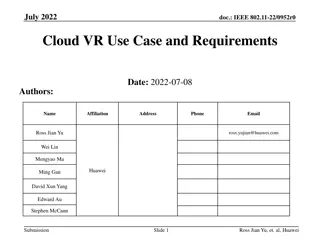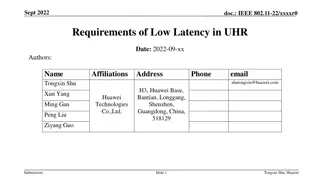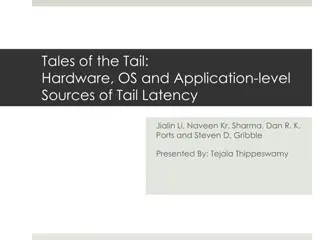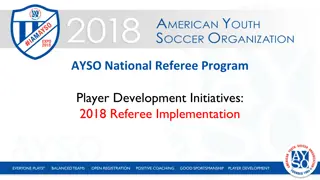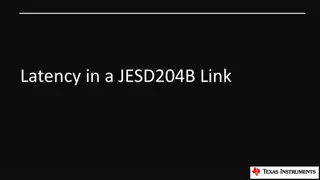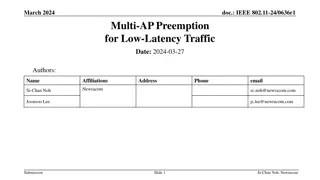Impact of Latency on Player Performance in Cloud-based Games
Research conducted by Mark Claypool and David Finkel explores the effects of latency on player performance in cloud-based games. The study compares the impact of latency on both objective (performance) and subjective (quality) measures, highlighting how every 100ms increase in latency results in a 25% decrease in performance. The research aims to inform developers of game and cloud systems about the implications of latency in cloud-based gaming compared to traditional network games.
Download Presentation

Please find below an Image/Link to download the presentation.
The content on the website is provided AS IS for your information and personal use only. It may not be sold, licensed, or shared on other websites without obtaining consent from the author. Download presentation by click this link. If you encounter any issues during the download, it is possible that the publisher has removed the file from their server.
E N D
Presentation Transcript
The Effects of Latency on Player Performance in Cloud-based Games Mark Claypool and David Finkel {claypool,dfinkel}@cs.wpi.edu Computer Science and Interactive Media & Game Development Worcester Polytechnic Institute 1
Cloud-based Games Connectivity and capacity of networks growing Opportunity for cloud-based games Game processing on servers in cloud Stream game video down to client Client displays video, sends player input up to server Game frames Server Server Server Player input Thin Client Cloud Servers 2
Motivation and Challenges Cloud-based games Server controls content, helps prevent piracy Easy to distribute games to many players Client thin , so inexpensive ($100 for OnLive console vs. $400 for Playstation 4 console) Potentially less frequent client hardware upgrades Challenges Requires more downstream capacity than traditional network games (5000 Kb/s vs. 50 Kb/s [1]) Latency since player input requires round-trip to server before player sees effects 3
Latency and Interactive Applications Numerous studies on latency and interactive applications (e.g., VoIP) But interactions for games different Numerous studies on latency and network games (e.g., car racing [2], role playing [3], first person shooter [4]) But cloud-based has only thin client so results may differ Some studies on latency cloud-based games (e.g., [6], [7]) But do not measure impact on users Few studies on latency cloud-based on users (e.g., [8]) Still need more data But does not compare with traditional network games Need to compare to traditional network games inform developers of game and cloud systems 4
Our Research Measure impact of latency on players in cloud- based games Two separate user studies two games, two systems Users play games with controlled amounts of latency Measure objective (performance) and subjective (quality) Compare performance to traditional network games 5
Teasers Player performance degrades directly with increase in latency Every 100 ms latency means 25% decrease in performance Degradation similar to traditional first person network games Despite difference in genres! E.g., third person game latency tolerance: Traditional network game 500 ms Cloud-based game only 100 ms 6
Outline Introduction User Studies Results Conclusion (done) (next) 7
User Study 1 OnLive console Connects to laptop configured as router Dummynet on router Control latency: 0-150ms Router connects to Internet then OnLive servers Users play Crazy Taxi 3rd person view Deliver customers for points About 12 minutes total Users volunteers from campus 8
User Study 2 GamingAnywhere LAN Client connects to PC configured as router Dummynet on router Control latency: 0-200ms Router connects to server on LAN Users play Neverball 3rd person view Roll marble to goal as fast as possible About 10 minutes total Users volunteers from campus 9
Outline Introduction User Studies Results Demographics Subjective Objective Traditional network games Conclusion (done) (done) (next) 11
Demographics OnLive Crazy Taxi: 49 users 95% 18-22 years old 70% male 75% average+ game playing experience GamingAnywhere Neverball: 34 users 100% 18-22 years old 90% male 100% average+ game playing experience 12
QoE for OnLive Crazy Taxi Subjective opinions combined [12] Mean with standard error Linear regression R2 0.92 QoE drop of 30% over 150 ms 13
QoE for GamingAnywhere Neverball QoE ranked for each test Mean with standard error Friedman test for correlation (p=0.002) Linear regression R2 0.86 QoE drop of 40% over about 200 ms 14
Points for OnLive Crazy Taxi Points for delivering customers Mean with standard error Linear regression R2 0.87 Score drop of 35% over 150 ms 15
Times for GamingAnywhere Neverball Time to get marble to goal Mean with standard error Linear regression R2 0.70 Time increase of 35% over about 200 ms 16
User Performance in Game Genres Traditional games Impact of latency depends upon perspective [5] First Person most sensitive Third Person less sensitive Omnipresent least sensitive 17
User Performance in Game Genres Cloud-based games most closely follow first person avatar Despite being third person! Convert objective measurements to performance degradation 18
Conclusion Cloud-based games increasingly relevant Effects of latency? Versus traditional network games? Two user studies on cloud-based games and latency Measure object (score) and subjective (QoE) Comparison with traditional games Cloud-based games sensitive to modest latencies 25% degradation for each 100 ms Most similar to first person games Even if genre more tolerant to latency in traditional games Future work Additional user studies, other genres Latency compensation for cloud-based games Effects of variation in latency (i.e., delay jitter) 19
Acknowledgements GamingAnywhere Neverball James Anouna Zachary Estep Michael French OnLive Crazy Taxi Robert Dabrowski Chrisitan Manuel Robert Smieja 20
The Effects of Latency on Player Performance in Cloud-based Games Mark Claypool and David Finkel {claypool,dfinkel}@cs.wpi.edu Computer Science and Interactive Media & Game Development Worcester Polytechnic Institute 21


